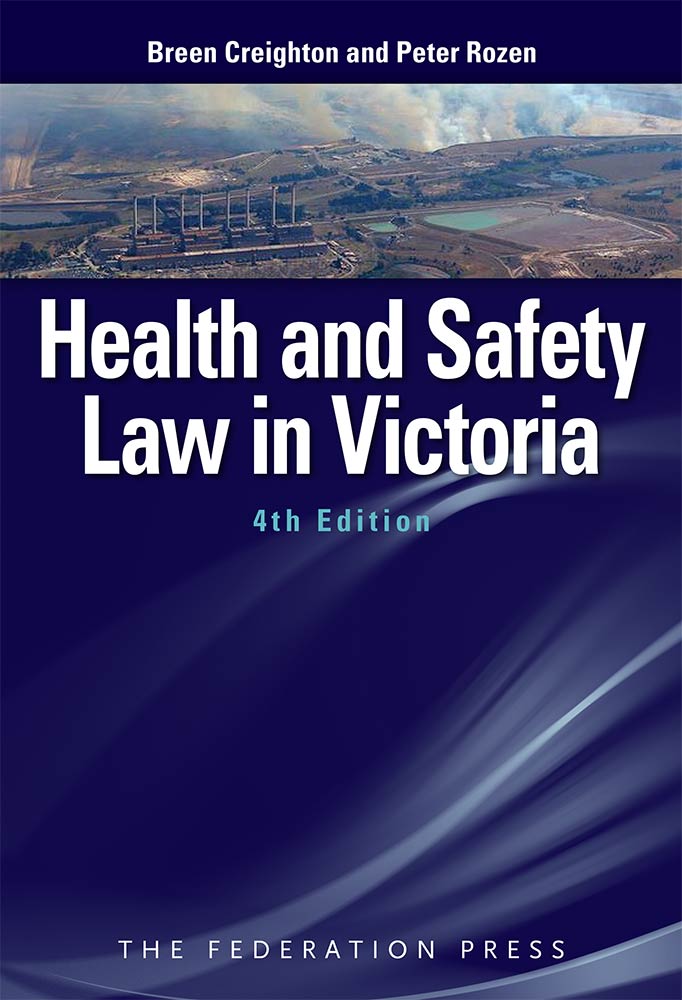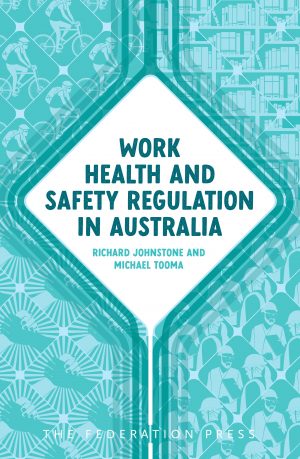This is an entirely re-written and greatly expanded edition of this standard text on occupational health and safety law in Victoria.
As with previous editions, it contains a detailed examination of the principal OHS statute in Victoria – the Occupational Health and Safety Act 2004. It also describes and analyses relevant aspects of other legislation which impinges on OHS regulation – such as the provisions of the federal Fair Work Act 2009 dealing with protection against victimisation because of OHS-related activity and right of entry to workplaces for OHS purposes.
Like its predecessors, the new edition makes extensive reference to OHS law and practice in other jurisdictions, and to relevant international labour standards, notably the International Labour Organisation’s Occupational Safety and Health Convention 1981 (No 155) and Promotional Framework for Occupational Safety and Health Convention 2006 (No 187).
Critically, the new edition locates the 2004 Victorian Act firmly in the context of the harmonised work health and safety regime which is enshrined in the model Work Health and Safety Act. Despite the fact that the Model Act was clearly based on the Victorian legislation, and is in force in most Australian jurisdictions, successive State Governments in Victoria have refused to sign up to the harmonised system.
The authors clearly recognise, however, that it is impossible to understand or to apply the 2004 Act in isolation from the harmonised system. This is reflected in the inclusion of a lengthy chapter describing the evolution and substance of the harmonised system, and in the fact that all provisions of the 2004 Act are cross-referred to the parallel provision in the Model Act. Consequently, the fourth edition of Creighton & Rozen provides a valuable guide to the origins and substantive provisions of the harmonised legislation, as well as a detailed analysis of the Victorian system.
The High Court in Deal v Kodakkathanath [2016] HCA 31 has taken an expansive view of the Occupational Health and Safety Regulations. In light of this case, this new edition of the book contains an expanded discussion of the civil breach of statutory duty action under the Occupational Health and Safety Regulations 2007 and 2017 which will be of interest to practitioners involved in work-related personal injury litigation.
Foreword by the Hon Chris Maxwell, President of the Victorian Court of Appeal
Preface
Table of Cases
Table of Legislation
Abbreviations
1. The Context
2. A National Approach to OHS Regulation
3. Interpreting OHSA 2004
4. Administration
5. General Duties – Key Concepts
6. General Duty of Employers to Employees
7. The Other General Duties
8. Standard-Setting: Regulation and Compliance Codes
9. Inspection and Securing Compliance
10. Criminal Enforcement
11. Personal Liability
12. Consultation, Representation and Participation
13. Victimisation
14. Right of Entry for OHS Purposes
15. Application to the Crown
16. OHSA 2004 in Perspective
Bibliography
Index
It is difficult to make a book about occupational health and safety (OHS) law interesting. Some try with creative design but the most successful is when laws are interpreted into real world circumstances. Thankfully Breen Creighton and Peter Rozen have written the latter in the 4th edition of Health and Safety Law in Victoria.
Kevin Jones, Safety at Work Blog, November 2018
There are not many textbooks in which the preface laments the fact that the new edition is required at all – but that is exactly the position taken by Breen Creighton and Peter Rozen in this fourth edition. The failure of successive Victorian governments to consider harmonisation of occupational health and safety legislation is, to the authors, “profoundly disappointing”.
It is the authors’ total investment to the outcomes of good safety legislation – the safety and wellbeing of all Victorian workers and their families – that makes this textbook not only authoritative but also essential. While deftly walking
the reader through the operation of
the Occupational Health and Safety
Act 2004, the authors are unafraid to challenge weaknesses in the Victorian legislation by reference to the law in other states and the UK.
This questioning approach constantly reminds the reader that the work in understanding workplace risks is never static and that the outcome sought should never be about compromise but instead about the best outcome to protect safety.
The authors have fulfilled their obligation in making the law clearly understood. It remains the duty of the Victorian government to ensure the rest.
Joseph Kelly, InPrint, Law Institute Journal Victoria, Jan/Feb 2018
*Phillip Taylor MBE from Richmond Green Chambers, London UK, reviews the book on YouTube channel – Click here to watch…
Uploaded September 2017
As the world is fast becoming one big jurisdiction, more or less, this new edition of the definitive work on health and safety law in the jurisdiction of Victoria in Australia will certainly be interesting, if not directly relevant, to lawyers everywhere, especially in jurisdictions within the Common Law.
It offers an interesting opportunity for comparative lawyers to compare; in this case the attendant problems of health and safety in Victoria with those of England and Wales.
The first edition of this long-established work came out in 1986 when the world in many respects was somewhat different. Since the previous edition of 2007, (from “The Federation Press”), further legislative developments have taken place, the ramifications and consequences of which are summarised in the authors’ preface.
Speaking of comparative law, the writers, Breen Creighton and Peter Rozen, mention an important influence in the development of health and safety over the past decade, as they refer to ‘the case law emerging from the United Kingdom, where the law has, at least until recently, been heavily influenced by developments in the European Union.’
It is a small world indeed and good thing too, as it has been an uphill battle over the decades to legislate for the perpetually fragile rights of employees just about anywhere, to decent standards of health and safety in the workplace and to enforce those rights. The authors voice more than a few strong opinions on the continuingly thorny problems of enforcement.
It would appear that the expression of fierce and probably dissenting opinions in a standard legal text is an ever so slightly stronger tradition in Australia than, say, in England and Wales.
Writing in the foreword, the President of the Victoria Court of Appeal, the Hon Justice Chris Maxwell, emphasises the view of the authors that ‘the law can and should do more’, as ‘the levels of work-related injury, illness and death remain unacceptably high.’ They chide the “painfully slow” progress to national uniformity (across Australia’s nine jurisdictions) and demand ‘better performance from the regulator in investigation, inspection and enforcement.’
The book certainly covers all the salient aspects of the legislation, too detailed to list here, but to name a few, these include inspection, criminal enforcement, personal liability, victimisation and of course, many more.
As no Australian lawyer can do without this book, it is probable that few international lawyers can do without it either, especially those with Australian colleagues and/or links with Australia-based law firms. For lawyers anywhere, including academic lawyers, this book is an enlightening read.
Phillip Taylor MBE, Richmond Green Chambers, London UK, September 2017
This is the fourth edition of a work that was first published in 1986. As the Hon Justice Chris Maxwell identifies in his foreword, this book is a comprehensive guide to the risk-based occupational health and safety (OHS) regime in Victoria.
The book is divided into 16 chapters that cover topics including, a national approach to OHS regulation, general duties, criminal enforcement and right of entry for OHS purposes. The authors have drawn on their expertise as academics, practitioners and policy advisers to produce this comprehensive work.
As well as being a technical manual for Victoria’s OHS regime, this book also provides a critical assessment of OHS regulation in Victoria and I commend it to anyone seeking to navigate the OHS regime in this state.
Queensland Law Reporter – 29 September 2017 – [2017] 38 QLR
Reviews of previous editions:
Now in its third edition, Occupational Health & Safety Law in Victoria makes a significant contribution to understanding the problem [of workplace injury, ill-health and death], how it is regulated, and the benefits and shortcomings of the current regulatory system in Victoria.
… The authors are experts in both the theory and practice of OHS law and must be commended for the thoroughness and cogency of their analysis.
Although they focus on Victorian law, the authors make useful comparisons with the law in other Australian jurisdictions and in Britain. This contributes to a fuller understanding of the area.
The book also deals effectively with the increasingly important and sometimes difficult question of Commonwealth-state relations in this area of labour law. The authors engage throughout in a robust analysis of the law and its administration, explaining clearly where, in their view, there are shortcomings and what might be done about them.
… This book will be invaluable to those who practise in the area and is highly recommended reading for anyone interested in OHS law and labour law generally.
Law Institute Journal (Victoria), October 2007
The authoritative source on occupational health and safety law in Victoria.
Labour & Industry
The text is written in non-technical language and provides a down-to-earth commentary on problems which may arise under the legislation.
Law Institute Journal of Victoria
A clarity of prose not often encountered in legal books.
Southland
A welcome edition for legal practitioners working in the area, not only in Victoria but throughout Australia.
Ethos






